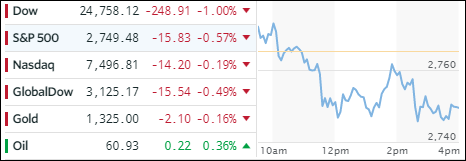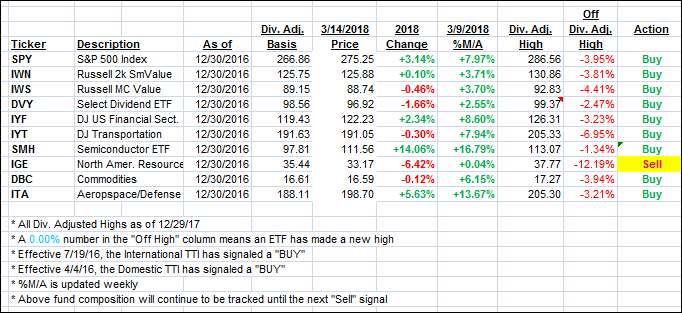- Moving the markets
A host of headlines appeared to punish the markets by pushing the major indexes down for the third day in the row. First, there was more jawboning about tough trade talk with China, as the administration announced a $100 billion annual China deficit target from last year’s $375 billion. Of course, retaliation is expected with one of the victims very likely being Boeing, whose stock subsequently got hammered for the second day in a row, which did not bode well for the Dow.
Then there was the matter of the GDP, as the Atlanta Fed (along with Goldman) slashed its forecast from its wild expectations of 5.4% down to a meager and far more realistic 1.9%, in part due to ever weakening retail sales, which had it worst declining streak since 2015. That was enough to take away some of the early bullishness and south we went. Despite a mid-day hiccup, the session was clearly dominated by the bears.
The Producer Price Index (PPI) had wholesale inflation up +0.2% in February (vs. +0.1% expected), but that was down from the 0.4% advance in January.
The VIX rallied above 17 and did its part to keep the markets in check. Interest rates dropped with the 10-year bond yield declining 3 basis points to 2.81%. The US Dollar, which sank for the 3 days in a row, managed to buck its trend by gaining +0.04%.
Overall, there was no news that could have boosted the markets. However, some ETFs in our portfolios withstood the negative sentiment as Semiconductors (SMH +0.05%), International ETFs (SCHF +0.26%) and International SmallCaps (SCHC +0.32%) managed to end this session in the green.
- ETFs in the Spotlight
In case you missed the announcement and description of this section, you can read it here again.
It features 10 broadly diversified and sector ETFs from my HighVolume list as posted every Saturday. Furthermore, they are screened for the lowest MaxDD% number meaning they have been showing better resistance to temporary sell offs than all others over the past year.
The below table simply demonstrates the magnitude with which some of the ETFs are fluctuating in regards to their positions above or below their respective individual trend lines (%M/A). A break below, represented by a negative number, shows weakness, while a break above, represented by a positive percentage, shows strength.
For hundreds of ETF choices, be sure to reference Thursday’s StatSheet.
Year to date, here’s how our candidates have fared so far:
Again, the %M/A column above shows the position of the various ETFs in relation to their respective long term trend lines, while the trailing sell stops are being tracked in the “Off High” column. The “Action” column will signal a “Sell” once the -7.5% point has been taken out in the “Off High” column.
- Trend Tracking Indexes (TTIs)
Our Trend Tracking Indexes (TTIs) slipped again as negative sentiment ruled the session.
Here’s how we closed 3/14/2018:
Domestic TTI: +3.53% above its M/A (last close +3.69%)—Buy signal effective 4/4/2016
International TTI: +3.61% above its M/A (last close +3.76%)—Buy signal effective 7/19/2016
Disclosure: I am obliged to inform you that I, as well as my advisory clients, own some of the ETFs listed in the above table. Furthermore, they do not represent a specific investment recommendation for you, they merely show which ETFs from the universe I track are falling within the guidelines specified.
Contact Ulli

